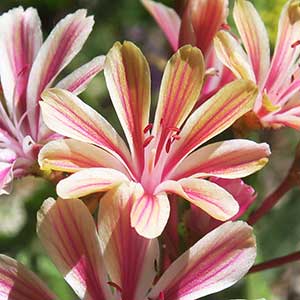Lewisia cotyledon
Lewisia brachycalyx
cliff lewisia, cliff maids, Siskiyou lewisia
short-sepal bitter-root, short-sepal lewisia
gradually ramified distally.
gradually ramified distally.
ascending to suberect, 10–12(–30) cm.
semiprostrate to suberect, 3–8 cm.
basal leaves evergreen, sessile or abruptly or gradually narrowed to broad petiole, blade oblanceolate, obovate, spatulate, or rarely ± linear or ± orbiculate, ± flattened, 3–14 cm, margins entire, crisped, or toothed, apex truncate, emarginate, retuse, or rounded;
cauline leaves alternate, intergrading with bracts, blade oblong to ovate, 5–10 mm, margins glandular-toothed, apex acute to occasionally obtuse.
basal leaves withering at or immediately following anthesis, ± sessile or tapered to broad petiole, blade oblanceolate, ± flattened, 3–8 cm, margins entire, apex acute to obtuse;
cauline leaves absent.
dense, paniculate to subumbellate cymes, 10–50-flowered;
bracts alternate or opposite proximally, 2 at each flowering node distally, obovate to lanceolate, 2–4 mm, margins glandular-toothed, apex acute.
flowers borne singly on peduncles;
bracts 2, ovate to broadly lanceolate, 5–7 mm, margins entire, apex acute to acuminate.
pedicellate, not disarticulate in fruit;
sepals 2, suborbiculate to broadly ovate, 4–6 mm, herbaceous at anthesis, margins glandular-toothed, apex obtuse to truncate;
petals 7–10, usually pink-purple with pale and darker stripes, less often white, cream with pink-orange stripes, ± orange, or yellow, oblanceolate, obovate, or spatulate, (8–)12–20 mm;
stamens 5–12;
stigmas 2–4;
pedicel 2–5 mm.
sessile, not disarticulate in fruit;
sepals 2, decussate with bracts, ovate, 4–9 mm, herbaceous, margins entire, not glandular, apex acute;
petals 5–9, white, sometimes with pink veins, or pinkish, obovate, 12–26 mm;
stamens 9–15;
stigmas 5–8.
3–5 mm.
6–9 mm.
4–15, 1.5 mm, shiny, smooth.
40–50, 1.5 mm, shiny.
= 20.
Lewisia cotyledon
Lewisia brachycalyx
Varieties 3 (3 in the flora).
The varieties occasionally co-occur. Natural hybrids with Lewisia leeana are known (see discussion under 8. L. leeana).
(Discussion copyrighted by Flora of North America; reprinted with permission.)
As B. Mathew (1989b) noted, plants attributed to New Mexico probably were collected in Arizona.
(Discussion copyrighted by Flora of North America; reprinted with permission.)
1. Basal leaf blade margins entire or slightly undulate, not toothed or crisped; petals (8-)12-14 mm | var. cotyledon |
1. Basal leaf blade margins strongly crisped or toothed; petals 12-20 mm | → 2 |
2. Basal leaf blade margins toothed. | var. heckneri |
2. Basal leaf blade margins strongly crisped | var. howellii |


